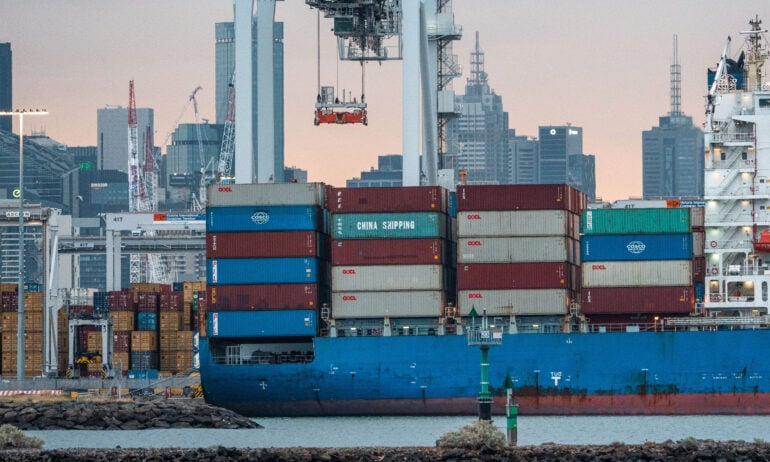What Is a Trade War and How Could It Raise Prices?
A trade war is an economic conflict in which countries engage in a cycle of retaliatory tariffs that drive up prices.

Many, or all, of the products featured on this page are from our advertising partners who compensate us when you take certain actions on our website or click to take an action on their website. However, this does not influence our evaluations. Our opinions are our own. Here is a list of our partners and here's how we make money.
Update on April 17.
More tariffs coming soon
The Trump Administration is likely to launch more targeted tariffs in the coming weeks and months, while leaving the door open to delaying others. Here are some of the possibilities, according to recent reports:
On Tuesday, President Donald Trump announced a new 21% tariff on tomatoes from Mexico will begin on July 14.
On Tuesday, Trump said he may make exemptions on auto part tariffs, which are set to begin before May 3.
On Monday, notices were posted in the Federal Register indicating national security probes were underway into imports of computer chips and pharmaceuticals.
On April 13, during an interview with ABC, Commerce Secretary Howard Lutnick said tariffs on smartphones, computers and other electronics would be coming soon. On April 11, the Trump Administration exempted those products from the new tariffs on China.
A trade war is an economic conflict in which countries enact tariffs or other trade barriers against each other in a vicious cycle. It ultimately makes trade more expensive, increases political tension and disrupts economies.
And President Donald Trump is escalating one.
In the weeks since taking office, Trump has announced wide-ranging tariffs targeting specific goods and trading partners, including large “reciprocal” tariffs tailored to each country sending goods to the U.S. Those tariffs are set to take effect on April 9. Meanwhile, a 10% across-the-board tariff on all imported goods will take effect April 5. See a list of the new tariffs below.
Trade wars are the result of economic or political tensions between two countries. They’re sparked by measures that a government takes — such as tariffs — to restrict foreign trade and protect domestic interests.
Trump has justified his latest tariffs as a response to trade partners’ practices that limit imports of U.S. goods, creating a lopsided relationship in which the U.S. imports more foreign goods than it exports. In a speech on April 2, Trump said the reciprocal tariffs will bring about a “golden age” for manufacturing in the U.S. He also claimed that the policies would create “trillions and trillions of dollars to reduce our taxes and pay down our national debt.”
Meanwhile, Trump says his steep tariffs on Canada and Mexico are a response to the influx of undocumented migrants, as well as fentanyl from across the northern and southern borders. He has also said that China hasn’t done enough to stop the flow of fentanyl to the U.S.
Trade wars are economically risky and typically lead to higher consumer prices, disrupt supply chains and impact world financial markets. They can strain relations between countries and, in the past, have even led to military conflicts.
How did the trade war start?
Major trading partners are expected to impose their own retaliatory tariffs in response to Trump’s new tariffs. We’ve seen that happen already. Canada, China and Mexico imposed or plan to levy tariffs on the U.S. in response to those put in place by Trump in March.
Canada: As of March 4, there is a 25% tariff on C$30 billion of U.S. goods. More 25% tariffs will be enacted after 21 days on C$125 billion of imports from the U.S. The total impact will be C$155 billion ($107 billion) of U.S. products.
China: Beginning April 10, the U.S. will face 34% tariffs on imports to China. New tariffs on agricultural imports from the U.S. began on March 10. That includes 15% tariffs on chicken, wheat, corn and cotton imports. There will also be 10% tariffs on sorghum, soybeans, pork, beef, aquatic products, fruits, vegetables and dairy products.
Mexico: President Claudia Sheinbaum planned to announce retaliatory tariffs on March 9, but those were delayed.
What tariffs are now in effect?
April 9: 145% total reciprocal tariff for China with exemptions. See the section on exemptions for more details.
April 9: 10% across-the-board reciprocal tariffs on all foreign imports. Additional tariffs on individual countries are delayed until July 9.
April 3: 25% tariff on all automobile imports.
March 12: 25% tariffs on all steel and aluminum imports.
March 4: 25% tariffs on some goods from Canada and Mexico; certain goods that are included in the U.S.-Mexico-Canada Agreement (USMCA) are exempt.
March 3: 10% additional tariff on China.
Feb. 4: 10% tariff on China.
Upcoming tariffs:
Before May 3: 25% tariff on auto parts imports.
July 9: Pause lifts for the additional tariffs on foreign countries first announced on April 2.
July 14: 21% tariff on tomatoes from Mexico.
Trump’s tariff exemptions
The Trump Administration is exempting certain products from its reciprocal tariff policies. Some of the products are already subject to a tariff or may be taxed in the future. Here’s how that breaks down:
Products with their own separate tariffs:
Steel and aluminum face their own 25% tariffs.
Automobiles, which face their own 25% tariffs.
Products that the White House is reportedly planning to target for future tariffs
Auto parts, which are expected to be taxed at 25% sometime before May 3.
Copper.
Pharmaceuticals.
Semiconductors.
Lumber.
Products entirely excluded from tariffs:
Any items and services included under the USMCA trade agreement.
Energy, including oil.
Other certain minerals not available in the U.S. The White House did not specify what this means.
Bullion, including gold.
Smartphones, computers, flat panel TVs, semiconductors, LED devices and other electronics.
The full list of exempted products is available here.
What happened in past trade wars?
The most notorious 20th century trade war resulted from the Smoot-Hawley Tariff Act of 1930, in which the U.S. imposed 40% to 60% tariffs on agricultural imports and over 20,000 imported goods. It was meant to curb foreign competition and protect businesses — especially American farmers — during the early days of the Great Depression. But the plan backfired and it triggered retaliatory tariffs from other countries. As a result, global trade tanked, worsening the depression.
The U.S. engaged in other trade wars in the past century, including:
The chicken war with Europe in the 1960s. The now-defunct European Economic Community imposed tariffs on imported chickens and the U.S. retaliated with 25% tariffs on light trucks, potato starch, dextrin and brandy.
The trade war with Japan in the 1980s. As Japan’s economic power grew, the U.S. imposed 100% tariffs on $300 million worth of Japanese imports.
The banana trade wars. In the 1990s, the U.S. and the European Union clashed over the banana trade. The EU favored banana producers in former European colonies in Africa, the Caribbean and the Pacific (ACP), which led to more expensive banana imports from Latin America — where U.S.-based banana companies sourced the fruit. The U.S. imposed tariffs on certain European imports and filed complaints with the World Trade Organization. The banana trade wars didn’t officially end until 2012.
Canada-U.S. softwood lumber wars. Since the 1980s, Canada and the U.S. have been in dispute over the price of “stumpage fees” for softwood lumber. The disputes have led to decades of tariffs, trade negotiations and lawsuits.
Steel tariff in 2002. The U.S. imposed 10% to 30% temporary tariffs on steel imports, which the EU retaliated against with tariffs on certain American goods. The World Trade Organization later ruled the policy illegal, leading to their removal.
2018-2019 trade war with China. In Trump's first term he levied tariffs on $350 billion of Chinese imports, while China retaliated with tariffs on $100 billion in U.S. exports.
Trade wars typically end through intervention, negotiations and compromises on trade or other policies.
How could a trade war affect consumers?
Prices would likely rise for goods imported from trading partners. That could include: certain foods, beer, coffee, tea, gas, clothing, jewelry, cosmetics, new cars, as well as consumer electronics like smartphones and computers. Home building supplies would get more expensive, which could discourage new construction and put added pressure on an already scant housing market.
In a trade war, prices would also increase the prices of goods made by U.S. manufacturers that require imported supplies. Tariffs could also foul up supply chains, which could further increase prices.
Several major companies, including Target and Best Buy, have already stated that the added costs of exporting and importing goods would be passed on to customers.
A Jan. 31 analysis by the nonpartisan Budget Lab at Yale University projects that the initial tariffs, in combination with retaliatory tariffs, could result in a loss of $1,245 in annual purchasing power for the typical U.S. household. And a Feb. 3 estimate by Peterson Institute for International Economics (PIIE) projects that the tariffs would likely slow growth and accelerate inflation.
How the trade war could escalate
Retaliatory tariffs could ignite a cycle of retaliatory tariffs that could exacerbate economic consequences and strain foreign relations. The U.S. trades with more than 200 countries worldwide and is the largest goods importer in the world, according to the Office of the United States Trade Representative.
Here are the latest tariffs that Trump announced on April 2:
(Photo by Asanka Ratnayake/Getty Images News via Getty Images)

